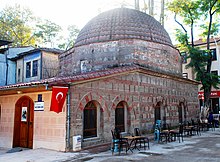Hacı-Ozbek Mosque
The Hacı Özbek Mosque ( Turkish: Hacı Özbek Camii ) on Hüseyin-Oktay-Straße near the Lefke Gate in İznik is one of the oldest mosque buildings of Ottoman architecture , built according to an inscription plate over a window in the year 734 AH / AD 1333 Hacı Özbek bin Muhammed, three years after Orhan I. conquered İznik.
architecture
The building consists of a square substructure measuring only 8 m², which is vaulted by an 8 m diameter dome. Narrow triangular gussets connect the dome with the square substructure via a twelve-sided drum . The masonry consists - in the building tradition of Byzantine architecture - alternating between three layers of brick and one layer of stone . The walls of the substructure are relatively low, so that the drum and dome optically dominate the building. The mosque is illuminated by five windows in the substructure and three in the dome. The outside of the dome is clad with specially shaped terracotta bricks. An innovation compared to the Byzantine architecture can be observed in the building: While the Byzantine builders mainly used bricks in standard sizes, which were cut down as required, the masonry of the Hacı-Özbek mosque was built from bricks specially shaped for the respective purpose.
In 1939 the three- yoke vestibule ( Son cemaat yeri ) was demolished due to a road expansion. Originally it had three pointed arches that rested on columns, Byzantine spolia . The northern yoke with the entrance to the mosque had a cross vault , while the other two yokes were covered with barrel vaults. There are niches in the side walls of the vestibule. In 1959 a new vestibule was built on the north side. There was never a minaret .
Web links
- Hacı-Özbek Mosque on archnet.org , accessed December 21, 2016.
- Floor plan of the mosque on YouTube , Turkish
- Exterior and interior views of the mosque on YouTube today
Individual evidence
- ^ Sheila Blair, Jonathan Bloom: The Art and Architecture of Islam, 1250-1800 . Yale University Press, New Haven 1994, ISBN 978-0-300-06465-0 , pp. 134 ( limited preview in Google Book search).
- ^ A b c Godfrey Goodwin: A History of Ottoman Architecture . Thames and Hudson, London 1971, ISBN 0-500-27429-0 , pp. 17 .
Coordinates: 40 ° 25 ′ 46 ″ N , 29 ° 43 ′ 24 ″ E
